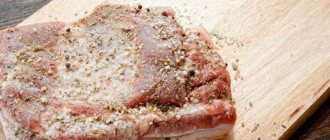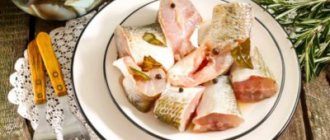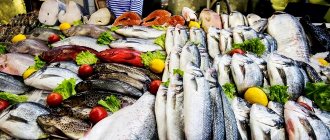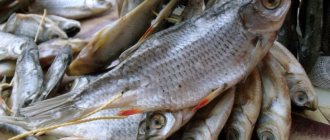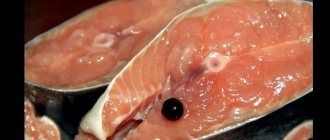It’s hard to come up with a more suitable beer snack than dried bream. This fish is easy to prepare, available for sale, and goes perfectly with a popular foamy drink.
The drying process itself includes several mandatory procedures: selection and preparation of fish, salting, soaking and final drying.
To achieve a good result, it is important not to deviate from time-tested technology, only then the dried fish will turn out tasty and look appetizing.
Where to start?
First of all, it is important to clearly understand why you need to dry at all. Initially, this is one of the oldest methods of storing meat and fish invented by people. During this process, the fish is deprived of excess moisture, after which it can be safely stored for a long time without much spoilage or visible loss of taste.
Fishermen have faced this problem for a long time. After all, after a successful fishing trip with a plentiful catch, something needs to be done. Especially on hot summer days, when freshly caught fish spoils as quickly as possible. Thus, the need for quick processing of the catch forced fishermen to use all the methods available to them to work with fish.
In the south of Russia, in the space between the Don and Volga, the same bream is dried in a simple (camping) way. The caught fish are gutted, washed, and then cut along the ridge and unfolded in the form of a “book.” Next, the flattened bream are rolled in a large amount of salt and hung on a rope in a freely ventilated place.
This is how the famous Tsimlyansky bream is prepared - quickly, efficiently and with not the worst taste result
At home, it is better to dry bream in another way. First of all, you need to pay attention to the quality of the raw materials. You should choose only fresh fish for subsequent drying - first-class bream and bream.
The fish must be thoroughly cleaned: remove mucus, rinse well, then remove the internal organs and rinse thoroughly again. Small specimens and fish with caviar, as a rule, are not gutted. It is also not customary to cut off the head of bream; the gills must be removed.
Only after completing these procedures can you start salting the fish.
Drying
Proceeding to the next stage, you should familiarize yourself with how to properly dry bream. The fish is dried in well-ventilated dry places. It is advisable that the room be darkened. In an apartment, drying can be done over a hot stove; for this, the fish is placed at a distance of 80 cm from it. To ensure that the heat is distributed evenly, the air is dispersed by a fan. How long to dry the bream depends on its size.
Fish are usually hung with their heads up, strung on wire or twine. The wire is threaded through the eye or the fish is hooked onto the lower lip. Insects can damage carcasses, causing harm to them. To prevent this from happening, you need to prepare a special solution and mix three parts unrefined sunflower oil and one part vinegar.
The resulting solution should be sprinkled on the carcasses. Tulle or gauze will also help. Another drying method is in the oven. This procedure requires preparation:
- The bottom of the oven is lined with foil;
- The fish are laid out in the same direction;
- Heat the oven and open the door 5 cm to allow air to circulate;
- After two hours, the heads of the carcasses are covered with foil, and the process is continued for another 4 hours.
Drying in the fresh air will be required. This can be done on the balcony. The fish will be ready in two days. The easiest option is drying using an electric dryer or convection oven. After 4 hours, a dried product is obtained, but drying will require a longer time.
Dry pickling
This stage is rightfully considered the most important and is invariably present in any recipe for dried bream.
Available fish should first of all be weighed. For dry salting, a simple proportion is used - 250 grams of salt per 1 kilogram of fresh fish. Moreover, it is better to take coarse salt, since it most effectively “removes” excess moisture.
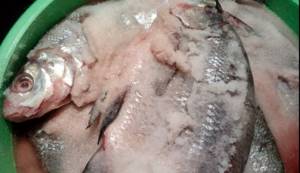
A good, spacious container for pickling will definitely come in handy. It should be doused with boiling water first.
After gutting the bream, removing the gills, black mucus and weighing, you can begin the process itself. A portion of the measured salt should be poured onto the bottom of the container to form a uniform layer about 1 cm thick. The remaining amount should be thoroughly rubbed onto the fish carcasses both outside and inside.
How to properly wither a roach
Next, the bream are placed in a container in dense layers, which are important to sprinkle with salt, and covered with something flat (a large plate, a cutting board). At the same time, the top fish are also covered with a layer of salt with a small addition of sugar in order to enhance the taste. It is very important not to forget to install some kind of pressure on top.
Oppression is important for several reasons. Firstly: this is the only way that dried bream will be dense. Secondly: when using oppression, air cavities will not appear inside the fish, in which harmful microorganisms love to accumulate.
It will take two days for high-quality salting. The container with fish is placed where it is cool. Within a few hours, the bream will release juice, and it is in it that the fish will be salted for the entire allotted time. Properly salted carcasses will eventually become elastic, the flesh will acquire a gray tint, and the caviar will become reddish-yellow.
Step-by-step recipe for drying bream
In order to prepare dried bream at home and on your own, you will need the following products:
- 3 kg of fresh bream;
- 600 g rock salt, coarse.
Which wood chips are best for smoking fish?
You can properly dry bream using step-by-step instructions.
- Rinse the fish in cool water so as not to damage the scales.
- Pour salt into a deep container and begin laying out the carcasses in layers, not forgetting to rub them generously with salt.
- When you're done with this, sprinkle everything with salt again.
- Cover everything with a lid or flat plate and place a weight on top.
- Cover everything with cellophane, but not tightly. This will prevent the fish from suffocating.
- After 3 days, soak the fish and dry it.
- Pass the wire through the gills and make rings out of it.
- For them, hang the fish on the balcony or in a mesh box outside.
Dried bream should dry for at least 6 - 7 days. After this you can remove and serve.
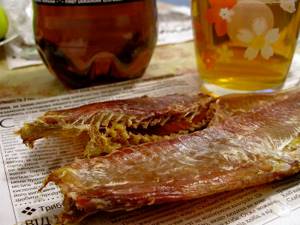
The easiest way to wilt bream is to follow a recipe with a photo, in which case you can visually see how and what to do
Soaking and drying
After two days, the resulting brine (brine) should be drained. Bream must be soaked in water to remove excess salt. There are different points of view on this matter. Some professionals advise soaking the fish for the same number of days as it was salted. There is a recommendation to soak for 10 hours. It is important to drain the water at least three times during the process.
Then comes the turn of the next stage - drying.

Bream should be hung in a cool room (basement, attic, balcony). A gauze canopy can be used as protection against insects.
Homemade gutted dried bream
If you want to cook tender dried bream, which you can safely brag about to your friends, you should bring your catch home and start performing sacred rituals over the fish in the kitchen. Before drying bream, it must be salted. We select a suitable spacious and deep container. We gut the bream, remove the gills and especially carefully remove the so-called “bud” - black mucus running along the ridge. Each carcass must be weighed to determine the right amount of salt. For a fish weighing 1 kilogram you will need 250 grams of salt. Pour some of the salt into the container and rub the rest of the fish inside and out. Place it in a container, cover it with a flat platform (a plate, a wooden board or a plastic lid will do) and place pressure on top. Now the bream should be left to salt for two days. This time can be spent usefully: for example, read on the website about ways to catch bream with a ring, bottom tackle or float and go fishing for a fresh catch!
Two days later, we drain the accumulated brine brine, wash the fish and dry it. The next step is drying. Bream should be dried in a cool room. The ideal place is the basement. An attic or balcony is also suitable if the weather is cool. It is not without reason that the best time for drying bream is considered to be autumn: the fish has already gained fat, the temperature outside is cool, and you can safely dry the bream on the open balcony. The optimal temperature for dried bream is from 0 to +15. Drying time is determined only by eye and depends on air access, weight of bream and temperature. On average, the process takes from a week to two. When cooked, such fish has an amber color of meat and a pleasant aroma. After this, dried bream is perfectly stored in the refrigerator, wrapped in newspaper or linen.

Drying
The ideal time for drying is autumn. The bream accumulate “fat” and the weather becomes suitable. Fish can be freely dried on the balcony at natural temperature.
The total time is determined experimentally - it depends on the air flow of the room, the size and weight of the fish, and the established temperature.
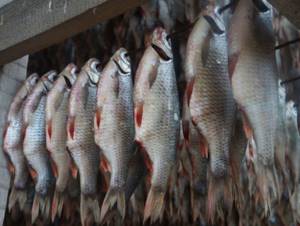
The average drying time is from one to two weeks.
The readiness of bream is determined by a number of characteristics. The structure of well-dried bream is uniform, freely visible in the light. There are no visible traces of salt. The flesh is elastic with an amber color of meat. The aroma is pleasant.
To improve the taste, wrap the bream in thick paper and keep it in the refrigerator for a while.
Recipes for making dried bream may vary slightly
Moreover, not the recipe - there is nothing special to change in it. Just add some spice. This is not for everybody. By carefully sorting out they find out what spices can be used to season the fish. Most connoisseurs of dried bream are convinced that any spices worsen its taste!

The cooking recipe may vary. Especially the salting process. It is carried out using different methods:
1. The dry (“Old Russian”) method is suitable for fish weighing more than a kilogram. The dry method is also suitable for salting small, ungutted bream. The fish is salted in wooden boxes with numerous holes made for the juice to flow out.
- The catch should not be washed: wipe with a cloth, removing mucus and dirt.
- A cut is made along the ridge and flattened.
- Clean out the insides.
- Pour salt there.
- Place belly up.
- Each layer is sprinkled with salt.
- They impose oppression.
- Place in a cool place for 4–7 days.
2. Wet method (in natural brine): salting is done in an enamel/plastic container. A centimeter layer of salt is poured onto the bottom. Whole carcasses are positioned so that the back rests on the belly of the nearby bream. Sprinkle with salt to form a smooth surface. Each new layer of fish is perpendicular to the previous laying. Oppression is placed on top. Excess juice is drained. Salted carcasses have a hard, slightly sunken back.
3. The brine method is suitable for small fish and low-fat fish that produce little juice. The white bream is strung on a fishing line and lowered into brine - a saturated salt solution. Keep for 2-3 days. (Checking the brine for strength: an egg floats in it.)
The drying process is complicated. The fish are hung out at night and kept in the refrigerator during the day. After 2-3 nights, each bream is wrapped in paper and placed on the bottom shelf of the refrigerator. There it reaches the desired condition for another 1-2 weeks, giving excess moisture to the paper. The wrappers are changed as they become damp to prevent mold from appearing. The finished bream turns out to be fatty and very tasty.
Wet salting
This method of pre-processing bream before drying is good for small specimens (less than 30 cm in length). Such fish are not cleaned of entrails, but only the gills are removed.
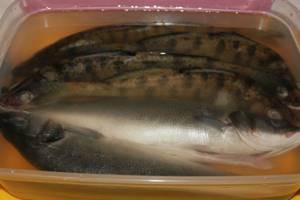
For salting, it is necessary to prepare a salt solution with good concentration
You need to dissolve enough salt in a container of water (bucket) so that the egg submerged in water rises to the surface.
Several fish are strung on a thick thread, fishing line or twine using a needle. Usually half a dozen carcasses are skewered on one thread. Then the bream are lowered into the solution with complete immersion.
After which it is important to close the bucket with bream tightly and put it in a cool place. The temperature there should not exceed 8 degrees Celsius. Salting will take 3 days. Readiness is determined by the elasticity and hardness of the backs. Then you can move on to the next stage.
How to salt a large bream whole
Large bream can also be salted using the brine method.
For this:
- first prepare a strong brine so that the raw egg does not sink in it (about 350 g per liter of water);
- then the brine is pumped into the syringe into the fish through the anus;
- put the carcasses in brine and take them out to a cool, dark place;
- after 2 days, the oppression is applied and left for 5 days; if the brine becomes cloudy, then it is removed and fresh is poured in;
- then washed for 2-3 hours and dried for a week or more.
- At the same time, measures are taken to eliminate flies.
Very large bream can be flattened, the entrails and heads removed, rubbed well with salt on both sides (300 g per 1 kg of bream) and placed flat or folded under pressure. After 3 days, soak the carcasses for 24 hours in changing water and send them to dry.
How to dry bream without gutting
For lovers of dried fish with caviar, you can suggest drying the bream without gutting, as a whole carcass.
For these purposes, only the freshest fish (less than 24 hours from the time of catch) is suitable. You need to immediately remove the gills from the bream, wash it and salt it. The salting process is the same as for gutted specimens. The only difference is the severity of the oppression. It is better to take something more massive, about half the weight of the entire fish.
After two days, the bream should be washed and then hung in a cool place (not higher than 10 degrees Celsius). A gauze canopy or mesh frame is required to protect against flies.
As for the benefits of dried bream for the body, it should be borne in mind that they contain a lot of fatty acids, calcium, and phosphorus. But there are also a lot of calories in such fish, as well as salt. Therefore, you should not go to extremes and eat exclusively dried fish. Everything is good in moderation.
Features of the drying process
As you know, not all types of fish can be dried. It is recommended to use only those that acquire a unique taste during processing in this way. This is precisely the property that is characteristic of bream. It is important to know how to dry bream correctly in order to avoid possible poisoning due to non-compliance with the technology. The essence of the process is that the fish must be well salted, after which it must be thoroughly soaked and dried. As a result, bream can be stored for a long time and eaten without any additional heat treatment. If you are interested in how many calories are in dried bream, then we can say that it is approximately 221 kcal per 100 g of product.
Salting bream for drying is a mandatory step. But it should be understood that it is intended to remove excess moisture from the fish, and not to improve its taste. Various methods can be used for the salting process: wet or dry. It is very important to know how to salt bream for drying, as this stage is considered one of the main ones and guarantees the preparation of delicious fish.
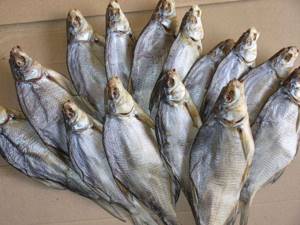
Dried bream: benefits and harms
Fish has a number of beneficial properties:
- — Contains a large amount of fatty acids that have a beneficial effect on the heart and blood vessels. By eating this tasty product, you can reduce the risk of hypertension, coronary artery disease, stroke and heart attack by at least 20%.
- “Due to the huge content of calcium, fluorine and phosphorus in bream, it is very beneficial for our teeth and bones.
- — Useful microelements contained in fish affect the human digestive system, improve the functioning of the gastrointestinal tract, and improve metabolism.
- — Regular consumption of bream meat prevents diseases of the mucous membranes and skin.
- — Experts have proven that constant consumption of bream serves as a prevention of thyroid diseases. Those people who constantly have this fish in their diet have practically no problems with the thyroid gland.
Meanwhile, dried bream is additional salt that enters the body, and therefore, in order not to harm yourself, you do not need to consume too much of this product.
Well, also, improperly salted and dried fish is a breeding ground for various bacteria, and therefore, after eating such a delicacy, you can get intestinal upset and even serious poisoning.
We suggest you familiarize yourself with: Do-it-yourself feeder feeders, how to tie them, which ones are better, video




